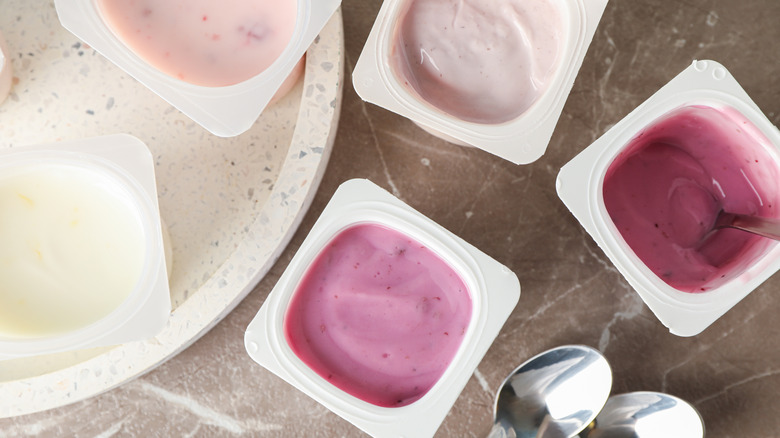The Most Popular Yogurt Flavor Is A Nostalgic Classic
When I think of breakfasts during my childhood, I'm reminded of my mom insisting I eat a cup of yogurt to ensure I get some calcium into my system — and there was only one flavor I could get down: strawberry. As I've aged, I've grown a stronger preference toward strawberry yogurt, and apparently, I'm not alone. Research shows strawberry to be the most preferred yogurt flavor in 2024, representing 34% of all yogurt sales in that year. As all yogurt flavors go, fruity yogurt flavors reign as the most popular choices, yet strawberry is at the top of the list for both spoonable and drinkable yogurt. With a strong association with nostalgia and sentimentality, the ever-comforting-and-tasty strawberry flavor appeals to young and old generations alike.
While people strive to incorporate more nutritious foods into their diets, they look to things like probiotics in yogurt to help maximize their health. This shift into physical wellness represents a booming social phenomenon: Now more than ever, people are intentionally working to look and feel their best through their food purchases and consumption. Yet this does not mean they can't eat delicious foods while doing so. The yogurt industry continually innovates its creations by combining tasty, nostalgic flavors like strawberry with healthy ingredients.
Familiar, nostalgic yogurts with healthy twists
Classic strawberry yogurt is hard to beat, but other popular flavors include vanilla, blueberry, peach, raspberry, and mango. Despite having different taste profiles, these flavors all share a few things in common — most glaringly, their ability to evoke feelings of comfort and nostalgia in their consumers. Some other nostalgic flavors include candy-like flavors like cotton candy and bubblegum, as well as homages to classic desserts like apple pie and banana pudding, and yogurt companies have capitalized on this. Chobani, a dominating brand in the Greek yogurt category, appeals to simplistic nostalgic flavors like ripe strawberry, Madagascar vanilla and cinnamon, and mixed berry while also distributing exotic nostalgic flavors like s'mores, orange cream pop, and apple pie à la mode.
But why is nostalgia such a driving factor in food sales and consumption? Well, the olfactory system (in charge of smell) is tethered to the parts of your brain that process emotion and memory. Since 75 to 90% of taste derives from smell, foods have the power to release fond — and sometimes not so fond — emotions and memories from 'back in the day'. Food industries such as the yogurt industry capitalize on this by merging this science-based fact with innovative ideas, creating familiar tastes with new twists.
Many new twists on foods involve a lighter or healthier rendition of a diet-unfriendly meal. As one-third of food spending is driven by health consciousness, players in the food industry must shift their attention toward utilizing healthy ingredients. The yogurt industry is no exception. Many yogurt companies decrease added sugar and increase probiotics and protein in their products. Companies such as Chobani, Fage, Siggi's, and Too Good all produce yogurts with nutrition labels you'll be happy to read — and all have variations of strawberry-flavored yogurt, too.

